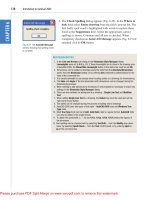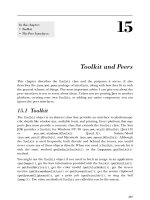Introduction to UML structural modeling and use cases
Bạn đang xem bản rút gọn của tài liệu. Xem và tải ngay bản đầy đủ của tài liệu tại đây (482.29 KB, 83 trang )
Introduction to UML: Structural
Modeling and Use Cases
Cris Kobryn
Co-Chair UML Revision Task Force
November 2000
Object Modeling with OMG UML Tutorial Series
© 1999-2000 OMG and Tutorial Contributors: EDS, IBM, Enea Data, InLine Software,
IntelliCorp, Kabira Technologies, Klasse Objecten, ObjectTime Ltd., Rational Software, Unisys
Introduction to UML 2
Overview
!
Tutorial series
!
Quick tour
!
Structural modeling
!
Use case modeling
Introduction to UML 3
Tutorial Series
!
Lecture 1: Introduction to UML:
Structural Modeling and Use Cases
!
Lecture 2: Behavioral Modeling with
UML
!
Lecture 3: Advanced Modeling with UML
!
Lecture 4: Metadata Integration with
UML, MOF and XMI
Introduction to UML 4
Tutorial Goals
!
What you will learn:
!
what the UML is and what is it not
!
UML’s basic constructs, rules and diagram
techniques
!
how the UML can model large, complex systems
!
how the UML can specify systems in an
implementation-independent manner
!
how UML, XMI and MOF can facilitate metadata
integration
!
What you will not learn:
!
Object Modeling 101
!
object methods or processes
!
Metamodeling 101
Introduction to UML 5
Quick Tour
!
Why do we model?
!
What is the UML?
!
Foundation elements
!
Unifying concepts
!
Language architecture
!
Relation to other OMG technologies
Introduction to UML 6
!
Provide structure for problem solving
!
Experiment to explore multiple solutions
!
Furnish abstractions to manage complexity
!
Reduce time-to-market for business
problem solutions
!
Decrease development costs
!
Manage the risk of mistakes
Why do we model?
Introduction to UML 7
Tijuana “shantytown”:
/>The Challenge
Introduction to UML 8
Fallingwater:
/>The Vision
Introduction to UML 9
Why do we model graphically?
!
Graphics reveal data.
!
Edward Tufte
The Visual Display of Quantitative Information,
1983
!
1 bitmap = 1 megaword.
!
Anonymous visual modeler
Introduction to UML 10
!
The UML is a graphical language for
!
specifying
!
visualizing
!
constructing
!
documenting
the artifacts of software systems
!
Added to the list of OMG adopted
technologies in November 1997 as UML 1.1
!
Most recent minor revision is UML 1.3,
adopted in November 1999
Quick Tour
Introduction to UML 11
! Define an easy-to-learn but semantically rich visual
modeling language
!
Unify the Booch, OMT, and Objectory modeling
languages
!
Include ideas from other modeling languages
!
Incorporate industry best practices
!
Address contemporary software development issues
! scale, distribution, concurrency, executability, etc.
!
Provide flexibility for applying different processes
!
Enable model interchange and define repository
interfaces
UML Goals
Introduction to UML 12
OMG UML Evolution
<<document>>
UML 1.1
<<document>>
UML 1.2
<<document>>
UML 1.3
<<document>>
UML 1.4
<<document>>
UML 1.5
1997
(adopted by OMG)
1998
1999
Q4 2000
(planned minor revision)
2001
(planned minor revision)
Editorial revision with no
significant technical changes.
<<document>>
ISO Publicly
Available
Specification
[read only]
<<document>>
UML 2.0
[backward compatible]
2002
(planned major revision)
The expected result of OMG's
formal liaison with ISO.
Introduction to UML 13
OMG UML Contributors
Aonix
Colorado State University
Computer Associates
Concept Five
Data Access
EDS
Enea Data
Hewlett-Packard
IBM
I-Logix
InLine Software
Intellicorp
Kabira Technologies
Klasse Objecten
Lockheed Martin
Microsoft
ObjecTime
Oracle
Ptech
OAO Technology Solutions
Rational Software
Reich
SAP
Softeam
Sterling Software
Sun
Taskon
Telelogic
Unisys
…
Introduction to UML 14
OMG UML 1.3 Specification
!
UML Summary
!
UML Semantics
!
UML Notation Guide
!
UML Standard Profiles
! Software Development Processes
! Business Modeling
!
UML CORBAfacility Interface Definition
!
UML XML Metadata Interchange DTD
!
Object Constraint Language
Introduction to UML 15
Tutorial Focus: the Language
!
language = syntax + semantics
! syntax = rules by which language elements
(e.g., words) are assembled into
expressions (e.g., phrases, clauses)
! semantics = rules by which syntactic
expressions are assigned meanings
!
UML Notation Guide
– defines UML’s
graphic syntax
!
UML Semantics
– defines UML’s
semantics
Introduction to UML 16
!
Building blocks
!
Well-formedness rules
Foundation Concepts
Introduction to UML 17
!
The basic building blocks of UML are:
!
model elements (classes, interfaces, components,
use cases, etc.)
!
relationships (associations, generalization,
dependencies, etc.)
!
diagrams (class diagrams, use case diagrams,
interaction diagrams, etc.)
!
Simple building blocks are used to create large,
complex structures
!
cf. elements, bonds and molecules in chemistry
!
cf. components, connectors and circuit boards in
hardware
Building Blocks
Introduction to UML 18
Diagram: Classifier View
Element
Carbon Hydrogen
<<covalent>>
<<covalent>>
C
C
C
H
Introduction to UML 19
Diagram: Instance View
:Carbon :Carbon
:Hydrogen
:Hydrogen
:Hydrogen
:Hydrogen
:Hydrogen
:Hydrogen
Introduction to UML 20
Well-Formedness Rules
!
Well-formed: indicates that a model or model
fragment adheres to all semantic and syntactic rules
that apply to it.
!
UML specifies rules for:
!
naming
!
scoping
!
visibility
!
integrity
!
execution (limited)
!
However, during iterative, incremental development
it is expected that models will be incomplete and
inconsistent.
Introduction to UML 21
Well-Formedness Rules (cont’d)
!
Example of semantic rule: Class [1]
! English: If a Class is concrete, all the Operations of
the Class should have a realizing Method in the full
descriptor.
! OCL: not self.isAbstract implies
self.allOperations->
forAll (op | self.allMethods->
exists (m | m.specification->
includes(op)))
Introduction to UML 22
Well-Formedness Rules (cont’d)
!
Example of syntactic rules: Class
! Basic Notation: A class is drawn as a solid-outline
rectangle with three compartments separated by
horizontal lines.
! Presentation Option: Either or both of the attribute
and operation compartments may be suppressed.
!
Example of syntactic guideline: Class
! Style Guideline: Begin class names with an
uppercase letter.
Introduction to UML 23
Unifying Concepts
!
classifier-instance dichotomy
!
e.g., an object is an instance of a class OR
a class is the classifier of an object
!
specification-realization dichotomy
!
e.g., an interface is a specification of a class OR
a class is a realization of an interface
!
analysis-time vs. design-time vs. run-time
!
modeling phases (“process creep”)
!
usage guidelines suggested, not enforced
Introduction to UML 24
Language Architecture
!
Metamodel architecture
!
Package structure
Introduction to UML 25
Metamodel Architecture
«metaclass»
Attribute
«metaclass»
Class
«metaclass»
Operation
«instanceOf»
<<metamodel>>
UML Metamodel
Analysis Model
The attribute fare of
the PassengerTicket
class is an instance of
the metaclass
Attribute.
The operation
issue of the
PassengerTicket
class is an
instance of the
metaclass
Operation.
«instanceOf»«instanceOf»
«instanceOf»
<<use>>
<<use>>
Represents the
User Object layer
of the 4-layer
metamodel
architecture
pattern.
«metaclass»
Class
<<metamodel>>
MOF Meta-Metamodel
«metaclass»
Operation
«metaclass»
Attribute
PassengerTicket
+total()
+issue()
+surrender()
+refund()
+issuedBy : Airline
+issuingAgent : TravelAgent
+fare : Currency
+tax : Currency
45723990550: PassengerTicket
+issuedBy : Airline = AcmeAirlines
+issuingAgent : TravelAgent = TerrificTravel
+fare : Currency = 1050.00
+tax : Currency = 57.56
«instanceOf»
From Modeling CORBA Applications with
UML chapter in [Siegel 00].









